| Software Music Machine Archive |
|
The Different Types of Microphones Explained
This will give you a practical understanding of the most popular types of microphones to help you decide which ones to use for your music.
The Main Types of Microphones:
Dynamic Microphones
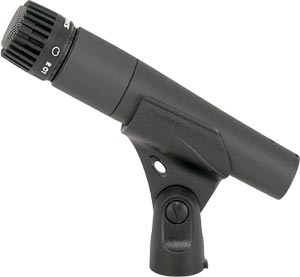
When you say microphone, the first image formed in your head is usually that of a typical Dynamic mic.
It continues to be the most popular variety, thanks to its exposure in concerts and live performances the world over.
Without going into too much detail, the strength of the dynamic mic lies in its simplistic operation. Generally, they have a lightweight diaphragm and a small coil of wire that works together to produce small electrical outputs that have to be amplified to be reproduced. Since it does not require overly sensitive electronics, it can be built to be robust, moisture resistant, and relatively inexpensive - making them road worthy and ideal for stage and live performance use. The downside of its simple design is that it cannot reproduce very high frequencies accurately, reducing the overall quality and detail of the sound being captured. Although the lack of frequency response limits the quality, this weakness is turned into strength, as helps dynamic mics to handle high sound pressure levels and to be more resistant to feedback, further strengthening its position as the best microphone for stage use. A good example of Dynamic microphones is the Shure SM57, one of the best-selling microphones in the world.
Condenser Microphones
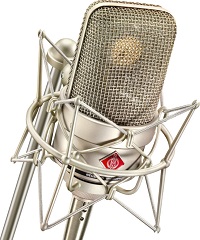
Condenser microphones, although not as popular as dynamic mics, are widely used in home and studio recording today.
It was invented at Bell labs back in 1916 and was also called a capacitor microphone, up to this day the core concept behind the design of condenser mics remain relatively unchanged.
Condenser mics are favored in recording because of their ability to capture audio with full detail. Unlike the simple design of dynamic microphones, condenser mics have a delicate pair of electrified conducting plates and a small built-in preamplifier that enables them to respond and reproduce sound more accurately. This complicated design requires phantom power and limits durability. The materials needed are also more expensive, adding to the overall cost. However, the cost and sensitivity of dynamic mics pay off really well in controlled music production environments like home studios and professional recording studios. Another feature unique to Condenser microphones is their ability to switch pickup patterns, improving their overall versatility. Familiar examples of condenser microphones brands include Røde and Neumman. It's also worth noting that you can get condenser mics with built-in A/D converters so you don't need an audio interface - see this Guide to USB Microphones for more information.
Electret Microphones
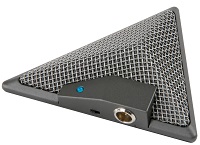
The vast majority of microphones being made today are electret micriphones, but ironically most are not familiar with this condenser mic variation.
Nearly all mobile phones, computers, PDAs, headset microphones - virtually all the small microphones in the gadgets that we have today are all electret types.
So basically, many of the modern songs that we hear today are first recorded as demos using electret microphones! This type of microphone offers the same functionality of condenser mics albeit with design changes that allow them to fit into very small sized containers. Although the typical electret mic will not be on par with the quality of condenser mics, they capture audio quite well and are inexpensive to reproduce - making them ideal for various gadgets that need basic recording. Their small-scale approach has revolutionized communications technology, and as technology advances, you might soon be seeing small microphones that can match if not out-perform your favorite expensive condenser mics.
Ribbon Microphones
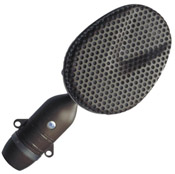
Ribbon microphones follow the same principle as dynamic mics, producing sound via magnetic induction. However ribbon microphones differ in the pattern that they pick up sound, which usually is bi-directional. Their general design is made up of a thin corrugated metal ribbon suspended in a magnetic field.
Their defining characteristic is in the way they capture audio from the front and back of the mic, while effectively rejecting the sides in a figure-eight pattern.
Although this pattern of capturing sound can be problematic, the high side rejection more than makes up for it, turning it into a versatile tool for recording multiple audio sources. You can capture sound, and reject noise in a variety of ways just by changing its position or placement relative to the source. Due to its fragile design and sensitive placement requirements, it is not as popular as the other mic types, however modern versions are now more robust, and in the hands of professionals, ribbon microphones can simplify recording various instruments.
Piezo Microphones
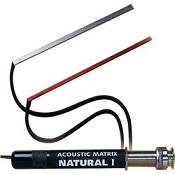
Piezo microphones are currently gaining popularity when it comes to mic'ing acoustic instruments. The design takes advantage of piezoelectricity, where in some materials can produce voltage when subjected to pressure or vibrations.
Also called contact microphones, piezos are widely used to amplify sound of acoustic music instruments.
These microphones have made it possible to retain the instrument's acoustic characteristics and tonality even when plugged in. Since they rely on contact and vibrations rather than sound, they can be useful for capturing other instruments like drums, electronic samplers, and they will work well even in sonically challenging situations. A popular example of this type of microphone is the Saddle mounted piezo pickups found on almost all acoustic-electric guitars today. They capture the vibration of the strings passing over the saddles and reproduces it as sound.
Related Articles:
The Best Mics For Home Recording
Roundup of Cheap USB Microphones
Best Drum Mics for Recording
Share This Article |